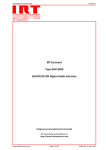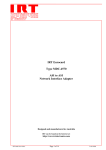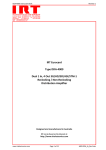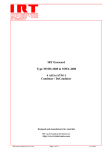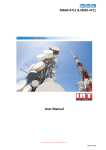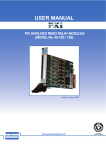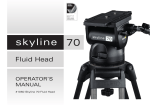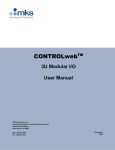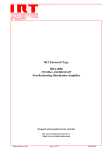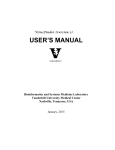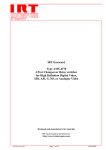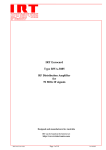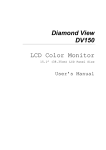Download User Manual - IRT Communications
Transcript
I R T Electronics Pty Ltd A.B.N. 35 000 832 575 26 Hotham Parade, ARTARMON N.S.W. 2064 AUSTRALIA National: Phone: (02) 9439 3744 Fax: (02) 9439 7439 International: +61 2 9439 3744 +61 2 9439 7439 Email: [email protected] Web: www.irtelectronics.com IRT Eurocard Type DVG-4090 SDI / Composite Test Pattern Generator with Crash Switching Designed and manufactured in Australia IRT can be found on the Internet at: http://www.irtelectronics.com 4090-dvg.ib.rev1.doc 1 of 29 22/10/2007 IRT Eurocard Type DVG-4090 SDI / Composite Test Pattern Generator with Crash Switching Instruction Book Table of Contents Section Page Operational Safety General Description Technical Specifications Configuration Link Settings Front Panel Indicators Front Panel Switch Controls Test Patterns Installation Rear Assembly Alarm Output Connection Front & rear panel connector diagrams Operation SDI Input Analogue Composite Input Front Panel Indicators Mode setting Examples of Mode setting outputs Banner Setting Test Pattern Setting Programming via USB interface Downloading of Banners and Pictures Setting of Audio Frequencies and Amplitudes Countdown Banner SNMP DVG-4090 SNMP Functions (Future) Maintenance & storage Equipment return 2 3 4 5 5 5 5 7 17 17 17 18 19 19 19 19 19 20 21 21 22 23 24 24 26 28 29 29 This instruction book applies to units later than S/N 0710001. Operational Safety: WARNING Operation of electronic equipment involves the use of voltages and currents that may be dangerous to human life. Note that under certain conditions dangerous potentials may exist in some circuits when power controls are in the OFF position. Maintenance personnel should observe all safety regulations. Do not make any adjustments inside equipment with power ON unless proper precautions are observed. All internal adjustments should only be made by suitably qualified personnel. All operational adjustments are available externally without the need for removing covers or use of extender cards. 4090-dvg.ib.rev1.doc 2 of 29 22/10/2007 IRT Eurocard Type DVG-4090 SDI / Composite Test Pattern Generator with Crash Switching General Description DVG-4090 Functional Diagram SDI I/P (SK4) SDI O/P 1 (SK9) RL1R-2 RL1R-1 SDI Equaliser & Carrier Detect Audio Embedder SDI Driver SDI O/P 2 (SK2) Composite I/P (SK3) 75 Ω RL2R-1 Composite Detector Comp O/P 1 Signal Processing Composite RL2R-2 Drivers Composite Encoder Comp O/P 2 (SK6) USB Port Comp O/P 3 (SK7) RL1 Front Panel Switches (SK5) Mode Banner Test Pattern Alarm O/P (J2) The DVG-4090 acts as an analogue / digital video crash switcher and test pattern generator. On loss of video input, output is automatically switched to a choice of 16 test patterns. 8 custom built banners containing text or pictures, such as station logos, and 2 full screen pictures can be downloaded by supplied software. Single banners can be overlaid or keyed onto the test pattern output in the lower section of the video picture. In the case of an SDI input, these banners can also be overlaid onto the existing stream. A countdown banner and audio test signal insertion is also available for link identification purposes. The DVG-4090 is designed to fit IRT’s standard Eurocard frames as well as IRT’s 4000 series frame for use with IRT’s SNMP system and may be used alongside any other of IRT’s analogue or digital Eurocards. Features: • • • SDI or Composite PAL/NTSC operation. Choice of 16 Test Patterns on loss of video input. Choice of 8 banners overlaid or keyed onto SDI input or Test Pattern output. 4090-dvg.ib.rev1.doc 3 of 29 22/10/2007 Technical Specifications IRT Eurocard Module DVG-4090 Input - Digital: Connector Format Equalisation 75Ω BNC. 270 Mbit/s SDI (SMPTE 259M), 625 or 525 line (link selectable). Automatic, better than 200 metres at 270 Mb/s for Belden 8281 or equivalent cable. Input - Analogue: Connector Format 75Ω BNC. PAL or NTSC (link selectable). Outputs - Digital: Number 2 x SDI (one with relay bypass when used with SDI input), 625 or 525 line (link selectable); 1 x SDI when used with analogue input link setting. 75Ω BNC. Re-clocked 270 Mbit/s SDI (SMPTE 259M). 800 mV ±10%. Connectors Format Signal Level Outputs - Analogue: Number Connectors 3 x Composite (one with relay bypass when used with analogue composite input), PAL or NTSC (link selectable). 75Ω BNC. Alarm Output: Closed relay contacts on loss of input signal. Power requirements: 28 Vac CT (14-0-14) or ± 16 Vdc. <4 VA. Power consumption Other: Temperature range Mechanical Dimensions 0 - 50° C ambient Suitable for mounting in IRT 19" rack chassis with input output and power connections on the rear panel Grey background, silk-screened black lettering & red IRT logo Detachable silk-screened PCB with direct mount connectors to Eurocard and external signals 32 mm x 3 U x 220 mm IRT Eurocard Standard accessories Digital and Analogue Rear connector assemblies. Finish: Front panel Rear assembly Due to our policy of continuing development, these specifications are subject to change without notice. 4090-dvg.ib.rev1.doc 4 of 29 22/10/2007 Configuration Link Settings: LK 1 OUT LK 1 IN 625 line (PAL) operation†. 525 line (NTSC) operation†. LK 2 Reserved. LK 3 Not used. LK 4 OUT LK 4 IN†† Inserted Channel 2 audio into SDI stream is continuous. Inserted Channel 2 audio into SDI stream is pulsed (interrupted on a cyclic basis – see †† note below). LK 5 OUT LK 5 IN SDI input selected. Analogue composite input selected. Note: † Unit will detect type of input signal whether it be 625 line or 525 line. Link LK1 affects the test pattern output on loss of input and so should be set to that of input signal. †† Link LK 4 IN is only effective with Banner switch set to Countdown position D. Front Panel Indicators: Input Loss (Red) – loss of video input. NTSC (Green) – 525 line (NTSC) video present. PAL (Green) – 625 line (PAL) video present. DC (Green) – power present. Front Panel Switch Controls: Mode 0 Three front panel hexadecimal rotary switches, marked Mode, Banner and Test Pattern, setup the DVG-4090 operation on loss of input. When using the DVG-4090 for SDI input, the Mode switch also allows for overlaying or keying on top of the input SDI signal. The tables below detail the switch setting operational functions: Switch Position 0 1 2 3 4 5 6 7 8 9 A B C D E F Function With Valid Input Input → Output Input → Output Input → Output Input → Output + Overlay* Input → Output + Overlay* Input → Output + Overlay* Input → Output + Key* Input → Output + Key* Input → Output + Key* Input → Output Input → Output Input → Output Input → Output + Overlay* Input → Output + Overlay* Input → Output + Overlay* SNMP Remote Output on Loss of Input Test Pattern only Test Pattern with Banner Overlay Test Pattern with Keyed Banner Test Pattern only Test Pattern with Banner Overlay Test Pattern with Keyed Banner Test Pattern only Test Pattern with Banner Overlay Test Pattern with Keyed Banner Test Pattern only + Audio Test Pattern with Banner Overlay + Audio** Test Pattern with Keyed Banner + Audio** Test Pattern only + Audio** Test Pattern with Banner Overlay + Audio** Test Pattern with Keyed Banner + Audio** SNMP Remote Note: * Overlaying and Keying for SDI input only, not valid for Composite input. ** Audio insertion for SDI outputs only, not valid for Composite outputs. Banners and Audio frequencies are initially loaded by user using supplied software and USB port on front panel. 4090-dvg.ib.rev1.doc 5 of 29 22/10/2007 4 Switch Position Banner 0 1 2 3 4 5 6 7 8 9 A B C D E F Function No frame – Input or test pattern only Banner 1 Banner 2 Banner 3 Banner 4 Banner 5 Banner 6 Banner 7 Banner 8 Banner Swap 1 & 2 Banner Swap 1 & 2 & 3 & 4 Banner Swap 5 & 6 & 7 & 8 Banner Swap 1 & 2 & 3 & 4 & 5 & 6 & 7 & 8 Countdown Picture 1 Picture 2 Note: Banners and Pictures are initially loaded by user using supplied software and USB port on front panel. Countdown position D must only be used with Mode settings set to Banner Overlay positions. B Test Pattern Switch Position 0 1 2 3 4 5 6 7 8 9 A B C D E F Function (Original Factory Setting) Test Pattern 0 Test Pattern 1 Test Pattern 2 Test Pattern 3 Test Pattern 4 Test Pattern 5 Test Pattern 6 Test Pattern 7 Test Pattern 8 Test Pattern 9 Test Pattern A Test Pattern B Test Pattern C Test Pattern D Test Pattern E Test Pattern F 75% Colour Bars 100% Colour Bars 2T 4T 20T Pulse & Bar DpDg 5 Step Y 2.5 MHz Bowtie Multiburst 60% Y Sweep 60% Y Sweep 100% Y Multipulse Y SinXX Y Valid Ramp Shallow Ramp Y Black Equaliser PLL Note: Test Patterns can be loaded or erased by user using supplied software and USB port on front panel. 4090-dvg.ib.rev1.doc 6 of 29 22/10/2007 Test Patterns: A number of test patterns, with full 10 bit resolution, are available for use with the DVG-4090, sixteen of which are preloaded into the unit when it is first purchased. The following images shown are from the SDI output as viewed on a Tektronix WFM 700 waveform monitor: Colour Bars 75% Colour Bars 100% 2T 4T 20T Pulse & Bar DpDg 4090-dvg.ib.rev1.doc 7 of 29 22/10/2007 5 Step Y 2.5MHz Bowtie Multiburst 60% Y Sweep 60% Y 4090-dvg.ib.rev1.doc 8 of 29 22/10/2007 Sweep 100% Y Multipulse Y SinXX Y Valid Ramp 4090-dvg.ib.rev1.doc 9 of 29 22/10/2007 Shallow Ramp Y Black Equaliser PLL 4090-dvg.ib.rev1.doc 10 of 29 22/10/2007 Using the supplied DVG-4090 software, the existing test patterns can be erased and replaced by any of the following supplied test patterns: 10 Step Y 10 Step YC 2T 4T 10T Pulse & Bar 2T Pulse & Bar NTSC 4090-dvg.ib.rev1.doc 11 of 29 22/10/2007 3 Channel Ramp 50% Flat Field 500kHz Bowtie Active Picture Timing 4090-dvg.ib.rev1.doc 12 of 29 22/10/2007 B-Y Valid Ramp Co-siting Pulse Gamut Limit Ramp 4090-dvg.ib.rev1.doc 13 of 29 22/10/2007 Modulated Ramp Multiburst 60% Multipulse NTSC Oversize Ramp 4090-dvg.ib.rev1.doc 14 of 29 22/10/2007 Red 75% Red 100% R-Y Valid Ramp Shallow Ramp YC 4090-dvg.ib.rev1.doc 15 of 29 22/10/2007 SMPTE Bars Sweep 60% YC Sweep 100% YC White 4090-dvg.ib.rev1.doc 16 of 29 22/10/2007 Installation Pre-installation: Handling: This equipment may contain or be connected to static sensitive devices and proper static free handling precautions should be observed. Where individual circuit cards are stored, they should be placed in antistatic bags. Proper antistatic procedures should be followed when inserting or removing cards from these bags. Power: AC mains supply: Ensure that operating voltage of unit and local supply voltage match and that correct rating fuse is installed for local supply. DC supply: Ensure that the correct polarity is observed and that DC supply voltage is maintained within the operating range specified. Earthing: The earth path is dependent on the type of frame selected. In every case particular care should be taken to ensure that the frame is connected to earth for safety reasons. See frame manual for details. Signal earth: For safety reasons a connection is made between signal earth and chassis earth. No attempt should be made to break this connection. Installation in frame or chassis: See details in separate manual for selected frame type. Rear Assembly: The DVG-4090 comes with a common rear assembly for use with either an SDI input or an analogue composite PAL or NTSC signal. Link LK5 sets whether the unit will work with the SDI input or analogue composite input. See Link Settings in Configuration section of this manual. Digital Video Connections: The digital SDI input and outputs are 75 Ω BNC type for connection with high quality 75 Ω coaxial cable. Input is self-terminating. No loop through facility is available. On loss of power to the module, the SDI input (SK4) is relay bypassed to SDI O/P 1 (SK9). Note that when the DVG-4090 is used for monitoring an analogue video signal (link LK5 IN) only one SDI output, SDI O/P 2 (SK2), is present as the digital output. Analogue Video Connections: When used with an SDI input, the rear assembly also includes 3 analogue video outputs, which are analogue representations of the SDI input or SDI test pattern generator, all of which are 75 Ω BNC type for connection with high quality 75 Ω coaxial cable. When used with an analogue composite video input (SK3), the analogue signal passes directly to composite output 1 (SK5) via a relay whilst a valid composite input signal is detected. On loss of sync the input is terminated in 75 Ω and the composite output switches to the selected test pattern output mode. Two other composite outputs (SK6 & SK7) are provided that match that of the main composite output (SK5) when the unit has lost a valid input. Note that when the DVG-4090 is used for monitoring an analogue video signal (link LK5 IN) only one SDI output, SDI O/P 2 (SK2), is present as the digital output Alarm Output Connection: A 2 pin connector is provide on the rear assembly for an alarm connection for loss of video input or loss of power. The common and normally closed pins of a relay come out on these connections and short together on an alarm condition. 4090-dvg.ib.rev1.doc 17 of 29 22/10/2007 Front & rear panel connector diagrams The following front panel and rear assembly drawings are not to scale and are intended to show relative positions of connectors, indicators and controls only. DV G- 4 0 9 0 PL1 SDI IN Alarm J2 Composite Input INPUT LOSS NTSC SK4 PAL SK3 Mode 0 SDI O/P1 4 SK9 Banner Composite 1 SK2 B Test Pattern SDI O/P2 SK5 Composite 2 USB DC SK6 Composite 3 PL2 SK7 N140 4090-dvg.ib.rev1.doc 18 of 29 22/10/2007 Operation Before use, setup the links as per the Link Settings in the Configuration section and ensure that the unit is correctly installed as per the Installation section of this manual. SDI Input: With link LK5 OUT the DVG-4090 takes an SDI feed as its input and outputs two regenerated SDI outputs and three composite analogue outputs, which are directly derived from the current SDI output. Depending on the position of the Mode switch it is possible to overlay or key the banner over the existing SDI input stream, if desired. On loss of the SDI input, all outputs (SDI & composite) output the test pattern as per the Test Pattern switch position, with or without banner overlay/keyed banner/embedded audio as per the Mode switch position. Audio embedding is only available on the SDI outputs. On loss of power to the DVG-4090, or if the module is removed from the rear assembly, the SDI input (SK4) is outputted directly to SDI O/P 1 (SK9) by a relay mounted on the rear assembly. Analogue Composite Input: With link LK5 IN the DVG-4090 takes an analogue composite feed as its input (SK3) and directly outputs itself to composite output 1 (SK5) via a relay on the rear assembly. As the source input is directed directly to its output, it is not possible to superimpose the banner directly over the incoming video signal as in the case of the digital rear assembly. A high impedance on board video detector also monitors the incoming composite video signal. On loss of video input, the chosen test pattern as per the Test Pattern switch position, with or without banner overlay/keyed banner as per the Mode switch position, relay switches to the main composite output (SK5). On loss of video, one SDI output (SDI O/P2 (SK2)) and the two other composite outputs (SK6 & SK7) match the main composite output (SK5). As the input signal is already being directly outputted to the main composite output by a relay on the rear assembly, loss of power or module removal will not affect operation of the video signal path. Front Panel Indicators: Front panel LEDs give a visual indication for loss of input video signal (red), whether the corresponding output signal is PAL-625 line (green) or NTSC-525 line (green), and power indication (green). Mode Setting: The front panel Mode switch, as well as the front panel Banner and Test Pattern switches, is a sixteen position rotary switch. Each position is marked in a hexadecimal sequence from 0 to F. The actual position is shown on the switch itself. As the switch is set back from the front panel, a flat bladed screwdriver is needed to adjust the position. The position number is also set back behind the front panel. The reason for setting the switches back was so that switch positions could not easily be set by hand and so not accidentally set to the wrong position by someone not authorised to do so. The Mode table, shown in the Configuration section of this manual, shows the functions of the switch position settings. With a valid input signal switch positions 0 to E will allow the input signal to pass from the input connector directly to the main output connector for the analogue rear assembly, regenerated with the digital rear assembly. Depending on the actual Mode switch position, the digital rear assembly also allows the SDI input signal to be superimposed with a banner overlay or keyed banner. On the loss of a valid input signal the resultant output test pattern, as determined by the Test Pattern switch position, will be either a test pattern only, a test pattern with banner overlay or a test pattern with keyed banner. It is also possible to add audio to the SDI test pattern as set by the supplied DVG-4090 software. Mode switch position F allows remote control operation via a Network Management System (NMS) provided the DVG-4090 is housed in an IRT 4000 series frame fitted with Simple Network Management Protocol (SNMP) functionality. 4090-dvg.ib.rev1.doc 19 of 29 22/10/2007 Examples of Mode setting outputs: Test Pattern only: Test Pattern with Banner Overlay: Test Pattern with Keyed Banner: 4090-dvg.ib.rev1.doc 20 of 29 22/10/2007 Banner Setting: Like the Mode and Test Pattern switches, the Banner switch is a sixteen position rotary hexadecimal switch. The Banner table, shown in the Configuration section of this manual, shows the functions of the switch position settings. A choice of eight banners and two pictures can be set to operate in conjunction with the Mode and Test Pattern switches. Settings also allow banners to cycle sequentially by approximately 2.5 seconds per banner. This can give the illusion of a flashing banner or movement. Banner switch position D is a special banner called Countdown. This is a moving bar graph and is described in detail later in this section. This position only works correctly for Mode settings set to Banner Overlay positions. Banner content may be text or pictures. It is up to the users to make their own banners or pictures, as these will be dependent on the situation required. Preloaded banners are for example only. Both banners and pictures need to be uncompressed 24 bit RGB bitmap (BMP) files. Banners need to be 720 x 72 pixels in size, whilst pictures must be 720 x 576 pixels for 625 line, or 720 x 480 for 525 line operation. Any drawing package capable of drawing bitmaps, such as Microsoft Paintbrush or CorelDraw, can be used to create banners and pictures. Banner 720 x 72 pixels: Banners can be overlaid or keyed over background video. For keying purposes, black background must be absolute RGB black (R=0, G=0, B=0). Banner black keying can be overridden by making the picture black not absolute RGB black. Example of company logo placement: Test Pattern Setting: Like the Mode and Banner switches, the Test Pattern switch is a sixteen position rotary hexadecimal switch. The Test Pattern table, shown in the Configuration section of this manual, shows the preloaded test patterns corresponding to the switch position settings. A choice of sixteen test patterns can be set to operate in conjunction with the Mode and Banner switches. As well as the sixteen default test patterns supplied, it is possible to change the test patterns to any of the other supplied test patterns by the use of the supplied DVG-4090 software. 4090-dvg.ib.rev1.doc 21 of 29 22/10/2007 Programming via USB interface: The DVG-4090 comes supplied with software and drivers for loading of banners and pictures, and changing of test patterns and audio parameters (audio parameters for SDI test pattern applications only). The DVG-4090 is connected to a PC running Microsoft Windows via a USB cable to the USB port on the front panel. The USB interface supports USB 1.1 and USB 2.0 full speed operation. When the USB cable is connected, the DVG-4090 automatically enumerates with Windows and requests drivers (supplied) if necessary. The DVG-4090 must be connected to the PC prior to executing the program and should not be disconnected until programming is complete. Execute the DVG-4090 program. Programming and erasing of the test patterns, banners and audio data can now be performed. Upon running the DVG-4090 program, the following window opens: 4090-dvg.ib.rev1.doc 22 of 29 22/10/2007 Downloading of Banners and Pictures: Up to 2 pictures, 8 banners and 16 test patterns can be downloaded to the DVG-4090. Choose the picture number, banner number or test pattern number you wish to over write by clicking the PC’s mouse over the number in the box corresponding to your choice. For example, clicking over the Banner Number opens the following box: Click on the Banner Number you wish to download and then click on the Download Banner button. The following window then opens: From here pick the banner that you wish to download to that particular Banner Number position. If your banner is not in this particular directory, change your directory path in this window. Remember that banners need to be created first as an uncompressed 24-bit RGB 720 x 72 pixel size bitmap (BMP) file using a suitable drawing program. Either double click on the banner name or highlight the banner name and click on the Open button. The existing Banner Number will be erased and the new banner overwritten. To erase a banner without overwriting with anything else just click on the Cancel button and no banner will be chosen to overwrite, but the existing banner will still be erased. Erasing a banner without overwriting with another leaves that banner position with a complete black background. Download is not complete until the Download Complete window appears: The same principal applies for downloading countdown, pictures and test patterns, however the test pattern files are supplied with the DVG-4090 software and are test line files with the filename extension “tst”. 4090-dvg.ib.rev1.doc 23 of 29 22/10/2007 Setting of Audio Frequencies and Amplitudes: The DVG-4090 also includes an in built audio generator for embedding four channels of audio within Group 1 of the SDI test pattern. Insertion is 48kHz synchronous at 20-bit resolution. There is no audio associated with the composite outputs on either the digital or analogue rear assemblies. Individual frequencies and amplitudes are set by the DVG-4090 software. Twenty-seven possible frequencies can be set on each of the four channels, these being: Silence, 50, 100, 150, 200, 250, 300, 400, 500, 600, 750, 800, 1000, 1200, 1500, 1600, 2000, 2400, 3000, 3200, 4000, 4800, 6000, 8000, 9600, 12000, & 16000 Hz. The maximum amplitude for each audio signal that can be set is 0.000 dBFS. Amplitudes less than or equal to 0.000 dBFS must be set, else an error message will be received and the software will not load. An example of various audio settings is shown below: Inserting audio channels within the test pattern can help determine particular audio channels within a stream or stream identifications. When used with the Countdown banner it is also possible to determine whether there is any audio lead or lag if the video signal passes through various signal processors, such as frame stores or video compressors for example. Countdown Banner: With the Banner switch set to the Countdown position D, the banner displayed is a moving bar graph as shown below: The Countdown banner is divided up in 1-second increments from 0 to 10. The bar of the graph moves up and down in time to the printed scale. This gives an indication that a system, such as a framestore or video encoder, has not frozen. A moving picture would obviously indicate whether a freeze frame has occurred, however a static test pattern would not. Having the moving bar allows the user to see instantly whether the test pattern image has frozen or not. Countdown position D needs the Mode switch set to a Banner Overlay position in order for the moving bar graph to work correctly. Although audio is generally embedded within an SDI stream, with processing through various systems such as video compression circuits it is still possible for the audio signals to get out of sync with the video signal. The Countdown banner provides marker points, corresponding to embedded audio channels 2, 3 and 4, which indicate when an interrupted audio signal should be heard to indicate audio sync with the SDI video signal. The markers correspond to the start of temporary ‘silence’ within the audio channel streams whilst the bar moves upwards from 0 to 10. Silence starting before the marker indicates that audio is leading the video, whilst silence starting after the marker indicates audio is lagging behind the video. If audio is embedded within the test pattern using the supplied DVG-4090 software, with link LK4 inserted and banner is set to Countdown position D, channel 2 audio will have a period of silence added to the audio stream every 8 seconds followed by 12 seconds. Audio channels 3 and 4 have periods of silence added to the audio streams regardless whether link LK4 is inserted or not. Channel 3 has a single 0.375 second period of silence added at the beginning of a 4 second interval. Channel 4 has two 0.375 second periods of silence added 0.75 seconds after the beginning of the same 4 second interval. 4090-dvg.ib.rev1.doc 24 of 29 22/10/2007 Channel 3 and Channel 4 audio streams have the following timing arrangement: 4 seconds 0.75 s 0.75 s Audio Channel 3 0.375 s Audio Channel 4 0.375 s 0.375 s Corresponding Marker Points 4090-dvg.ib.rev1.doc 25 of 29 22/10/2007 SNMP What Is It? SNMP stands for Simple Network Management Protocol. It is an application layer protocol for managing IP (Internet Protocol) based systems. SNMP enables system administrators to manage system performance, and to find and solve system problems. SNMP runs over UDP (User Datagram Protocol), which in turn runs over IP. Three types of SNMP exist: SNMP version 1 (SNMPv1), SNMP version 2 (SNMPv2) and SNMP version 3 (SNMPv3). It is not the intention here to discuss the differences between various versions, only to bring attention to the fact that IRT Electronics modules, fitted with SNMP capability, use SNMPv1. An SNMP managed network consists of three key components: Network Management Systems (NMS), agents, and managed devices. An NMS is the console through which the network administrator performs network management functions, such as monitoring status (e.g. alarm states) and remote controlling, of a set of managed devices. One or more NMSs must exist on any managed network. Generally the NMS is a computer running third party SNMP control software. There are a number of third party SNMP software applications currently available on the market. An NMS polls, or communicates with, an agent. An agent is a network management software module that resides in a managed device. An agent has local knowledge of management information and translates that information into a form compatible with SNMP. The agent, therefore, acts as an interface between the NMS and the managed devices. The NMS sends a request message, and control commands for the managed devices, to the agent, which in turn sends a response message, containing information about the managed devices, back to the NMS. A managed device contains an SNMP agent and resides on a managed network. Managed devices collect and store management information and make this information available to NMSs using SNMP. Managed device agent variables are organised in a tree structure known as a Management Information Base (MIB). Within the MIB are parameters pertaining to the managed device. An Object Identifier (OID) number within the MIB defines the managed device type. This is a unique number specific to the model of managed device. Other information relating to the device is also stored, information such as alarm states, controllable settings, etc. The MIB tree is organised in such a way that there will be no two MIB files with conflicting placements. Normally an NMS polls an agent for information relating to the MIB in a managed device to be sent back to the NMS. When certain conditions are met within the MIB, such as major alarm conditions, for example, the agent automatically sends what is known as a trap to the NMS without any prompting from the NMS. This allows automatic notification of a predetermined event. SNMP Block Diagram NMS IP Network NMS 4090-dvg.ib.rev1.doc 26 of 29 SNMP Agent Protocol Engine MIB SNMP Agent SNMP Agent Protocol Engine MIB SNMP Agent SNMP Agent Protocol Engine MIB SNMP Agent 22/10/2007 SNMP with IRT Products IRT Electronics currently employs SNMPv1 with its 4000 series frame. The frame acts as an agent when fitted with a CDM-4000 module. This module has its own designated slot next to the power supply so as to not affect the number of modules that the frame will take. Communication between the NMS, the frame and its loaded modules are via this CDM-4000 module. Note that the NMS software is third party and not supplied by IRT Electronics. Ethernet connection for SNMP operation is via an RJ45 connector on the rear of the frame, below the mains inlet. Ethernet rate runs at either 10 baseT or 100 baseT. Frame parameters, such as Name, Address and Location, are set via an RS232 interface, a D9 connector on the rear of the frame below the mains inlet. A software terminal emulator, such as Tera Term or HyperTerminal, is used for setting and reading the parameters of the frame. IRT modules that are SNMP compatible need a plug-in SMU-4000 module with a program relevant to the module that it is plugged into. Depending on the module, besides the module identification, parameters such as alarm states, inputs and controls etc. are communicated to the CDM-4000 agent via a data bus on the rear of the frame. Thus the CDM-4000 collects information on what is loaded within the frame, what positions they occupy, and their current status for communication to the NMS when the NMS sends a request for information. In the event of a major alarm from any of the SNMP compatible modules, or power supplies, a trap is automatically sent by the CDM-4000 agent to the NMS without any prompting by the NMS. This alerts the operator to any fault conditions that may exist that need immediate attention. 110/240 V 50/60 Hz 0.7 A (max.) FRU-4000 FRAME FUSES 220/240 Vac 500 mA S.B. 110/120 Vac 1A S.B. RS232 Alarm Ethernet + 48Vdc AS3260 approval no.: CS6346N Ass. no.: 804692 IRT SNMP Connections IRT modules fitted with SMU-4000 NMS Ethernet Cable IP Network CDM-4000 PSU’s IRT 4000 Series Frame Ethernet Cable IRT modules fitted with SMU-4000 CDM-4000 PSU’s IRT 4000 Series Frame Ethernet Cable IRT 4000 Series SNMP Setup 4090-dvg.ib.rev1.doc 27 of 29 22/10/2007 DVG-4090 SNMP Functions: (Future): With the Mode switch set to the SNMP position F, and the DVG-4090 installed in an IRT 4000 series frame with SNMP capability, the DVG-4090 can be interrogated by an SNMP Network Management System (NMS). The following SNMP functions are capable of being monitored and controlled by an NMS: An indication that the video input is present and whether it is Composite or SDI and PAL or NTSC; An indication of whether the output is set for 625 or 525 line operation; An indication whether audio channel 2 is set for continuous or pulsed operation; Selection of Mode function; Selection of Banner function; Selection of Test Pattern function; Whether “Trap” function is enabled; Trap automatically sent, if enabled, if the input signal fails; Unit reset control. 4090-dvg.ib.rev1.doc 28 of 29 22/10/2007 Maintenance & storage Maintenance: No regular maintenance is required. Care however should be taken to ensure that all connectors are kept clean and free from contamination of any kind. This is especially important in fibre optic equipment where cleanliness of optical connections is critical to performance. Storage: If the equipment is not to be used for an extended period, it is recommended the whole unit be placed in a sealed plastic bag to prevent dust contamination. In areas of high humidity a suitably sized bag of silica gel should be included to deter corrosion. Where individual circuit cards are stored, they should be placed in antistatic bags. Proper antistatic procedures should be followed when inserting or removing cards from these bags. Warranty & service Equipment is covered by a limited warranty period of three years from date of first delivery unless contrary conditions apply under a particular contract of supply. For situations when “No Fault Found” for repairs, a minimum charge of 1 hour’s labour, at IRT’s current labour charge rate, will apply, whether the equipment is within the warranty period or not. Equipment warranty is limited to faults attributable to defects in original design or manufacture. Warranty on components shall be extended by IRT only to the extent obtainable from the component supplier. Equipment return: Before arranging service, ensure that the fault is in the unit to be serviced and not in associated equipment. If possible, confirm this by substitution. Before returning equipment contact should be made with IRT or your local agent to determine whether the equipment can be serviced in the field or should be returned for repair. The equipment should be properly packed for return observing antistatic procedures. The following information should accompany the unit to be returned: 1. 2. 3. 4. 5. 6. 7. A fault report should be included indicating the nature of the fault The operating conditions under which the fault initially occurred. Any additional information, which may be of assistance in fault location and remedy. A contact name and telephone and fax numbers. Details of payment method for items not covered by warranty. Full return address. For situations when “No Fault Found” for repairs, a minimum charge of 1 hour’s labour will apply, whether the equipment is within the warranty period or not. Contact IRT for current hourly rate. Please note that all freight charges are the responsibility of the customer. The equipment should be returned to the agent who originally supplied the equipment or, where this is not possible, to IRT direct as follows. Equipment Service IRT Electronics Pty Ltd 26 Hotham Parade ARTARMON N.S.W. 2064 AUSTRALIA Phone: Email: 4090-dvg.ib.rev1.doc 61 2 9439 3744 [email protected] 29 of 29 Fax: 61 2 9439 7439 22/10/2007





























